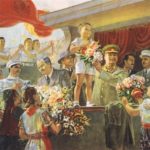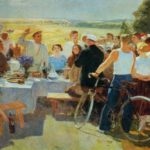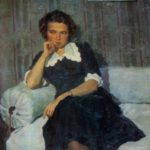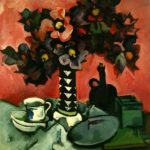Arefiev Anatoly Vasilievich Soviet theater artist

Arefiev Anatoly Vasilievich For more than thirty years of creative life A.V. Arefiev has designed over 70 opera and ballet performances. Among them: “Carmen” by J. Bizet (1949), “Swan Lake” by P.I. Tchaikovsky (1949), “Prince Igor” by A.P. Borodin (1954), “Toktogul” by V.A. Vlasov, A. Maldybaeva, V.G. Feret (1958), “The Unknown Soldier” by K.M. Molchanov (1967).
Arefiev Anatoly Vasilievich Soviet theater artist, People’s Artist of the USSR since 1967.
Born on November 24, 1918 in the city of Stavropol, Samara province. Since 1947 he worked as a set designer at the Kyrgyz Opera and Ballet Theater in Frunze, and since 1949 as the chief designer of this theater.
Working as the chief artist of the Academic Opera and Ballet Theater of Kyrgyzstan, A.V. Arefiev took a leading place in the Kyrgyz decorative arts. The creativity of A.V. Arefieva is one of the most interesting facets of musical theater. He skillfully subordinated artistic solutions to musical images. With laconic, precise means of expressiveness, he conveyed the mood of a particular picture of the play.
The versatility of talent, the sharpness of artistic perception, the taste of the master of scenery, his rejection of the traditional illusory solution of pictorialism are manifested in all the performances he designed.

Church
From the very beginning, when theatrical art was just emerging, the artist was immediately put on a par with the co-authors of the play, along with the playwright, director, stage director, and scenography was an active component of theatrical action. Moreover, the artist was presented with a choice: either to arrange the performance according to the creative manner, limiting himself to the description of everyday life, or, on the contrary, to rise to high generalizations. Working on the creation of the visual image of the performance, the artist, as a rule, first prepared sketches for literally each character, performer, determined the makeup, wig, props and props. Anatoly Vasilievich Arefiev did the same.
Career
Starting his career as a performer, he persistently engaged in self-education, stubbornly studying scenography from books, devoted a lot of time to sketches for the design of performances, actively participated in the recreation of old performances.
The artist’s creativity was most clearly manifested in the scenery for tragic performances, and in each in its own way, with characteristic features. The scenery for the opera by V. Vlasov, A. Maldybaev and V. Fere “Toktogul” talentedly “sounded” the tragedy of the people’s suffering, the akyn’s longing at will; in S. Prokofiev’s ballet Romeo and Juliet, the tragedy of love of two young lovers blows from the stage. Great compositional and constructive integrity was achieved in the sketches for “Boris Godunov”. Capacious depiction in the design of the ballet “Laurencia”, the convincing power of images and the atmosphere of reality in the “Bakhchisarai Fountain”.

Firebird
In the 60s, Anatoly Vasilyevich worked on the stage design of many wonderful opera and ballet works:
- 1965 “Optimistic Tragedy” by A. Kholminov;
- 1966 “Romeo, Juliet and the Darkness” by M. Molchanov;
- 1967-1968 “Quiet Don” by I. Dzerzhinsky;
- 1954, 1969 The Barber of Seville by G. Rossini;
- 1956, 1969 “The Sleeping Beauty” by P. Tchaikovsky.
In 1968-1969. the ballet “Spartacus” by A. Khachaturian is staged. And here again the talent of the master set designer manifested itself, each time discovering the original stage images. And Rome is a city, as if forever chained.

The virgin
The performances designed by A.V. Arefiev
- 1948 La Traviata, Kim Cantti.
- 1949 “Swan Lake”, “Carmen”, “Kokul”, “Altyn Kyz”.
- 1950 “Zaporozhets beyond the Danube”, “Doctor Aibolit”, “The Queen of Spades”, “Anar”.
- 1951 “On the shores of Issyk-Kul”, “Rusalka”.
- 1952 “Taras Bulba”, “Cherevichki”, “May Night”, “Aydar and Aisha”, “Red Poppy”.
- 1953 “Spring is Coming”, “Aleko”, “Cholpon”, “Rigoletto”.
- 1954 “Prince Igor”, “Angelo” (Russian Drama Theater named after NK Krupskaya), “The Barber of Seville”.
- 1955 “Esmeralda”, “Arshin Mal-Alan”, “The Bartered Bride”, “Teremok”.
- 1956 “Toktogul”, “The Taming of the Tamer” (Russian Drama Theater named after N. Krupskaya), “Pagliacci”, “The Sleeping Beauty”.
- 1957 “Cherevichki”, “Oprichnik”.
- 1958 “Cholpon”, “Toktogul”, the final concert of the decade.
- 1959 Chio-Chio-San, Ai-Churek.
- 1960 “Aida”, “Boris Godunov”, “Tricks of Maysara”.
- 1961 Eugene Onegin, Big Waltz, Jamilya, Peter and the Wolf.
- 1962 “Tales of Hoffmann” (Kazakh Opera and Ballet Theater, Alma-Ata), “Romeo and Juliet”, “Laurencia”.
- 1963 “Mother’s Heart”, “Francesca da Rimini”, “Spanish Capriccio”, “Egyptian Nights”, a gala concert dedicated to the 100th anniversary of the voluntary entry of Kyrgyzstan into Russia.





